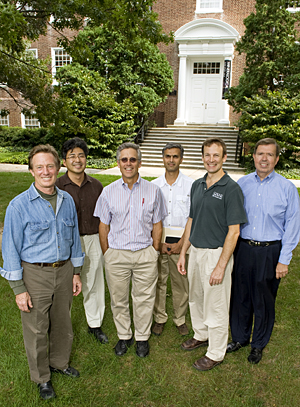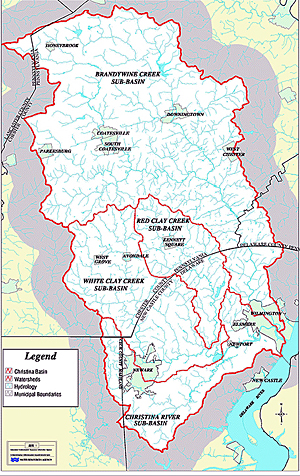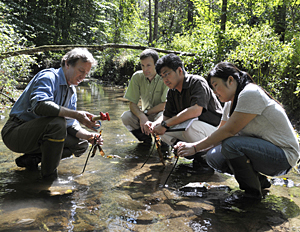


- Rozovsky wins prestigious NSF Early Career Award
- UD students meet alumni, experience 'closing bell' at NYSE
- Newark Police seek assistance in identifying suspects in robbery
- Rivlin says bipartisan budget action, stronger budget rules key to reversing debt
- Stink bugs shouldn't pose problem until late summer
- Gao to honor Placido Domingo in Washington performance
- Adopt-A-Highway project keeps Lewes road clean
- WVUD's Radiothon fundraiser runs April 1-10
- W.D. Snodgrass Symposium to honor Pulitzer winner
- New guide helps cancer patients manage symptoms
- UD in the News, March 25, 2011
- For the Record, March 25, 2011
- Public opinion expert discusses world views of U.S. in Global Agenda series
- Congressional delegation, dean laud Center for Community Research and Service program
- Center for Political Communication sets symposium on politics, entertainment
- Students work to raise funds, awareness of domestic violence
- Equestrian team wins regional championship in Western riding
- Markell, Harker stress importance of agriculture to Delaware's economy
- Carol A. Ammon MBA Case Competition winners announced
- Prof presents blood-clotting studies at Gordon Research Conference
- Sexual Assault Awareness Month events, programs announced
- Stay connected with Sea Grant, CEOE e-newsletter
- A message to UD regarding the tragedy in Japan
- More News >>
- March 31-May 14: REP stages Neil Simon's 'The Good Doctor'
- April 2: Newark plans annual 'wine and dine'
- April 5: Expert perspective on U.S. health care
- April 5: Comedian Ace Guillen to visit Scrounge
- April 6, May 4: School of Nursing sponsors research lecture series
- April 6-May 4: Confucius Institute presents Chinese Film Series on Wednesdays
- April 6: IPCC's Pachauri to discuss sustainable development in DENIN Dialogue Series
- April 7: 'WVUDstock' radiothon concert announced
- April 8: English Language Institute presents 'Arts in Translation'
- April 9: Green and Healthy Living Expo planned at The Bob
- April 9: Center for Political Communication to host Onion editor
- April 10: Alumni Easter Egg-stravaganza planned
- April 11: CDS session to focus on visual assistive technologies
- April 12: T.J. Stiles to speak at UDLA annual dinner
- April 15, 16: Annual UD push lawnmower tune-up scheduled
- April 15, 16: Master Players series presents iMusic 4, China Magpie
- April 15, 16: Delaware Symphony, UD chorus to perform Mahler work
- April 18: Former NFL Coach Bill Cowher featured in UD Speaks
- April 21-24: Sesame Street Live brings Elmo and friends to The Bob
- April 30: Save the date for Ag Day 2011 at UD
- April 30: Symposium to consider 'Frontiers at the Chemistry-Biology Interface'
- April 30-May 1: Relay for Life set at Delaware Field House
- May 4: Delaware Membrane Protein Symposium announced
- May 5: Northwestern University's Leon Keer to deliver Kerr lecture
- May 7: Women's volleyball team to host second annual Spring Fling
- Through May 3: SPPA announces speakers for 10th annual lecture series
- Through May 4: Global Agenda sees U.S. through others' eyes; World Bank president to speak
- Through May 4: 'Research on Race, Ethnicity, Culture' topic of series
- Through May 9: Black American Studies announces lecture series
- Through May 11: 'Challenges in Jewish Culture' lecture series announced
- Through May 11: Area Studies research featured in speaker series
- Through June 5: 'Andy Warhol: Behind the Camera' on view in Old College Gallery
- Through July 15: 'Bodyscapes' on view at Mechanical Hall Gallery
- More What's Happening >>
- UD calendar >>
- Middle States evaluation team on campus April 5
- Phipps named HR Liaison of the Quarter
- Senior wins iPad for participating in assessment study
- April 19: Procurement Services schedules information sessions
- UD Bookstore announces spring break hours
- HealthyU Wellness Program encourages employees to 'Step into Spring'
- April 8-29: Faculty roundtable series considers student engagement
- GRE is changing; learn more at April 15 info session
- April 30: UD Evening with Blue Rocks set for employees
- Morris Library to be open 24/7 during final exams
- More Campus FYI >>
2:36 p.m., Sept. 28, 2009----The University of Delaware, in collaboration with Stroud Water Research Center in Avondale, Pa., has received a $4.3 million grant from the National Science Foundation to establish the Christina River Basin as a new “Critical Zone Observatory” for researching questions relating to climate change.
Scientists define the “critical zone” as the portion of the planet from the treetops to the groundwater that sustains terrestrial life.
The observatory is one of only six in the United States. It is funded through a competitive, five-year grant awarded by the National Science Foundation (NSF) as part of the American Recovery and Reinvestment Act.
Donald Sparks, S. Hallock du Pont Chair in Soil and Environmental Chemistry and director of the new Delaware Environmental Institute at UD, will lead the effort, which involves a multidisciplinary team of scientists.
Sparks's co-principal investigators on the grant include Kyungsoo Yoo, assistant professor of plant and soil sciences, and James Pizzuto, professor of geological sciences, both at UD; and Anthony Aufdenkampe, assistant research scientist, and Louis Kaplan, senior research scientist, both at Stroud Water Research Center.
The research team also includes Shreeram Inamdar, associate professor of bioresources engineering; Delphis Levia, associate professor of geography; Yan Jin, professor of plant and soil sciences; Paul Imhoff, professor of civil and environmental engineering; Holly Michael, assistant professor of geological sciences; and Dominic DiToro, Edward C. Davis Professor of Civil and Environmental Engineering -- all from UD; senior research scientists Denis Newbold and Tom Bott at Stroud Water Research Center; and Rolf Aalto, who is on the faculty at the University of Exeter in the United Kingdom and at the University of Washington.
Using the 565-square-mile Christina River Basin as their laboratory, the scientific team will be working to determine how, and how rapidly, soil erosion and sediment transport through rivers impact the exchange of carbon between the land and the atmosphere, and affect climate.
“Over the centuries, we humans have been a major geological force, re-contouring entire landscapes through our activities,” Sparks notes. “Our new Critical Zone Observatory will work to quantify the impact of these activities on carbon and climate. We're excited to have the opportunity to explore these important scientific questions and look forward to collaborating with our colleagues at Stroud Water Research Center on the effort,” Sparks says.
“The Christina River Basin is already one of the best studied watersheds of its size in the nation, with more than 40 years of research conducted by the Stroud Water Research Center and governmental agencies,” Sparks adds, “but answering the big questions of earth and environmental science requires extensive real-time data and a collaborative effort that the cyber-infrastructure of this Critical Zone Observatory will make available to scientists around the nation.”
Ideal natural laboratory
The Christina River Basin includes five counties and 60 municipalities in Delaware, Pennsylvania, and Maryland, and encompasses Brandywine Creek, White Clay Creek, Red Clay Creek, and the Christina River and their watersheds. It is an ideal natural laboratory to research how humans affect the critical zone, the scientists say, because of its diverse regions ranging from more pristine areas, to second-growth forests, agricultural fields, suburban settings, and highly industrialized and urbanized areas.
“Erosion and excavation activities expose minerals that mix with organic matter in soils and are transported through streams and rivers to the sea,” says Aufdenkampe. “We want to better understand how the interaction of carbon with minerals might sequester that carbon from the atmosphere, where it acts as a greenhouse gas, and also understand how humans have altered that process. To do that effectively, we need to take a whole watershed approach to studying these processes at multiple scales in order to put them all together into a predictive model. That would be a significant contribution,” Aufdenkampe notes.
The Stroud Water Research Center, founded in 1967, seeks to advance knowledge and stewardship of fresh water through research, education, and global outreach to help businesses, landowners, policy makers, and individuals make informed decisions that affect water quality and availability around the world. The independent, not-for-profit organization has conducted pioneering research on rivers and streams on local to international levels, including more than 40 years of studies in the Christina River Basin. Part of White Clay Creek actually flows through the Stroud Water Research Center's laboratories.
The research team will focus on the sources, transport, and fates of water, sediments, and carbon from uplands to inland waters and from inland waters to the coastal zone. These niche regions will provide the students involved in the program -- eight graduate students from UD and more than a dozen undergraduates at Stroud Water Research Center -- with valuable multi-scale field training.
Cutting-edge technologies will be used for real-time gathering of hydrological, physical, and chemical data. Advances in cyber-infrastructure that seamlessly merges real-time data with state-of-the-art graphics will further establish the new Critical Zone Observatory as a community resource for sharing scientific data and public information.
Field installations and data management will enhance an extensive existing network of stations used for monitoring water flow and water chemistry within the Christina River Basin, including Delaware coastal waters, and will build upon a solid foundation of decades of research conducted by UD, Stroud Water Research Center, and numerous state, federal, and non-governmental agencies.
A partnership with NSF's National Center for Airborne Laser Mapping will provide for the collection and processing of extremely detailed and accurate topographic data by Light Detection and Ranging (LIDAR) measurements. Colleagues at the University of California at San Diego, the University of Washington, University of Exeter, and the U.S. Geological Survey also will assist with specific scientific analyses.
Outreach to policy makers, public
Besides serving as a resource to the greater scientific community through open access to data and opportunities for research projects that take advantage of the enhanced monitoring network, the Critical Zone Observatory also will provide outreach to policy makers and the public.
Partners on the outreach effort include several other UD research centers and programs including the new Delaware Environmental Institute, the Delaware Experimental Program to Stimulate Competitive Research (EPSCoR), and the Water Resources Agency in the Institute for Public Administration.
Results also will be shared regularly with the Christina Basin Water Quality Management Committee, which includes representatives from 15 federal, state, and local environmental resource agencies and hosts an annual series of public workshops to identify the science needs of policy makers.
Additionally, the Stroud Water Research Center maintains four full-time staff members to translate research into educational programs for middle and high school students and teachers, and citizen/conservation groups.
The new Critical Zone Observatory at the University of Delaware joins five other such observatories in the United States -- based at Pennsylvania State University, the University of Pennsylvania, University of Arizona, University of Colorado, and University of California Merced.
Article by Tracey Bryant
Photos by Kathy F. Atkinson and Evan Krape


